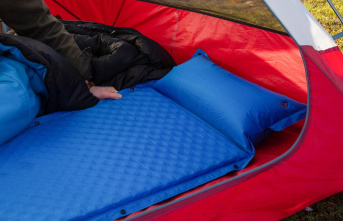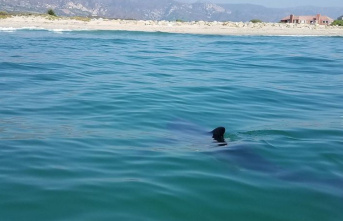It's only millimeters that separate me from the mouth of the robot crocodile, which snaps shut out of nowhere. I instinctively flinch - and can hear my son's howling laughter through the headphones. "Dad, why are you so scared?" he asks. Rightly so. Because although I can only see the dangerous jungle of a gloomy world full of deadly robots when I look around me, I'm actually just sitting on the couch in my living room. Without being exposed to any real dangers.
The fact that my pulse is still significantly higher is due to the immersion in virtual reality. With the new PSVR2, Sony has given its Playstation 5 its own VR experience. The technology should make the computer games a completely different experience. This works very well in the test - but the new glasses do not (yet) solve the basic problems of VR.
Sony has really put a lot of effort into this. The new glasses resolve their OLED displays in 2000 x 2040 pixels - for each eye individually. With a field of view of 110 degrees and a very high refresh rate of between 90 and 120 frames per second, it is one of the technically best VR glasses on the market.
What is often only statistics for fans with other devices brings real advantages with VR glasses. The high resolution not only ensures that the well-known fly screen effect can only be seen if you look very closely. Because the images shown have a particularly high resolution, the immersion also increases and the flickering of edges decreases significantly. The fast refresh rate is even more important. If the glasses show too few images, this not only creates a jerky effect. It also increases the risk of getting sick while playing.
The fact that this can unfortunately also set in after a while with the PSVR2 has the same reason as seasickness on a ship: what is seen does not match the feeling of the body. If the ship sways while the cabin remains calm, you get seasick below deck. With VR it's exactly the opposite: In the game you move wildly - while your body remains still.
In fact, the effect only occurs in one game in my test: When I chase wildly through space in a spaceship in "No Man's Sky", which otherwise feels simply great, and the ground appears over my cockpit, nausea quickly sets in. When I previously explored the planet on foot, that was just as missing as in other games that rely less on hectic movements and headstands. That's quite an achievement. With the predecessor of the glasses for the PS4, I always got sick after 20 minutes, no matter what game.
However, the experience in VR differs greatly depending on the game. In "Horizon: Call of the Mountain" you have to climb mountains with your arms, shoot with your bow at the robot beasts described above. And feels right in the middle of the action. In the platformer "Moss 2" the experience is completely different, but no less fascinating. There you take the position of an external camera with the glasses while you control a cute little mouse through the varied levels. Nevertheless, you feel much closer to the character - because you feel like part of the game world.
You notice how quickly you forget the world around you when you bump into the couch or a table. Because although you feel part of the VR world, you naturally continue to move in real space.
Sony has cleverly solved how to deal with it. The PSVR2 has sensors and cameras on the outside that scan the environment around the venue with every session - and with change of carrier. You can also see the space around you through the glasses. Once you're in the game, you'll be warned by a kind of digital grid if you've moved too much. This avoids accidentally throwing the vase off the table. In the test, this worked very reliably both sitting and standing. Nevertheless, it happens that you occasionally reach your limits with the edge of the couch or another piece of furniture. With a quick repositioning, however, this is quickly solved.
Ease of use, however, starts with the setup. If you connect the glasses for the first time, you only have to work your way through an easy-to-understand and easy-to-use tutorial. And can start right away. The hurdle to using virtual reality is thus reduced enormously.
The glasses themselves are surprisingly unobtrusive. Both the seat on the head and the distance to the eyes can be comfortably adjusted. However, glasses could not be worn underneath. This can be a problem for people who are farsighted, but as a nearsighted person I had no problems because of the lenses placed just in front of my eyes. The weight and the glasses themselves did not cause any discomfort even when worn for a long time. The absolutely necessary cable connected to the Playstation 5 is so long that I had no problems even at a distance of four meters from the console.
The controllers also feel good. In principle, it is a simplified and split version of the Dualsense. The controllers, each adapted for one hand, both come with an analog stick, two buttons on the top and two on the bottom and on the side. And of course, both react in detail to the player's movements.
How well this works depends on the game. And here's the big crux of PSVR2: There is currently no real must-have experience. With "Horizon: Call of the Mountain", Sony has created its own VR experience for one of its most popular game series. However, compared to the great, highly complex original (here is our review of the latest installment, Forbidden West), it feels overly simplistic and far less satisfying. The same applies to many other games for PSVR2: they often cannot keep up with the highly developed gaming experience that you are used to by now.
Of course you can't blame Sony alone. Because: While graphics, controls and the structure of games have been continuously optimized, VR experiences are still in their infancy in comparison. Which certainly has something to do with the fact that the market is still very small and simply cannot bring in the huge budgets of top games. In general, competitive VR games are still in short supply. The only real must-play, "Halflife:Alyx" has only been released for the PC so far. Rumor has it that it could also be released for the PS5.
This is a problem for customers for one reason in particular: VR is still very expensive in comparison. And the PSVR2 also costs more with an RRP of 600 euros than the PS5, which is not cheap anyway - which you also need, however. And then you don't even have a game. For the VR experience, which has been structured quite simply so far, this is pretty steep.
The good news is that both problems could slowly resolve themselves over the next few years. The real boom for virtual reality is still missing, but with mass products like the PSVR 2 and VR glasses from Apple expected later this year, the breakthrough could slowly be within reach. Once the developers have a large enough customer base, it's finally worth putting the extra effort into VR games. And: In the course of time, the prices should also slowly fall.
With its second VR glasses, Sony has achieved what VR has needed for years: easy-to-use, well-designed VR glasses with mass appeal. The glasses fit well, are very easy to set up and just as easy to use. The hardware also leaves little to be desired.
The glasses share the greatest weaknesses with all competitors: the VR experience is still relatively immature compared to other games. In view of the high price, this makes it difficult to give the glasses a purchase recommendation right from the start. But if you really want to try VR, don't let the price put you off and already own a PS5, you can buy it without hesitation. The hardware and its implementation are among the best on the market.












